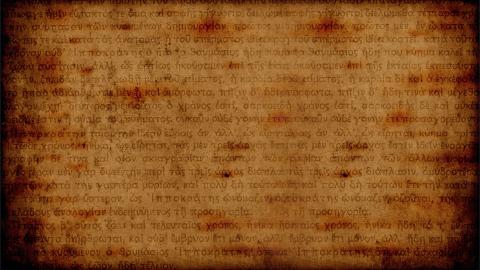
Researcher Discovers Fragment of 1,750-Year-Old Translation of Gospel of Matthew
A researcher at the Austrian Academy of Sciences has discovered what scientists say is a fragment of the oldest writing of the text of Matthew from the Bible's New Testament.
The biblical text had been hidden underneath other writing on an ancient piece of parchment.
"About 1,300 years ago a scribe in Palestine took a book of the Gospels inscribed with a Syriac text and erased it. Parchment was scarce in the desert in the Middle Ages, so manuscripts were often erased and reused," the academy, also known as OeAW or Österreichische Akademie der Wissenschaften, explained in a recent post on its website.
Medievalist Grigory Kessel, one of the members of the OeAW research team, used ultraviolet photography to reveal the ancient transcription which was located underneath three layers of text. The layered manuscript, a so-called palimpsest, is now legible again using modern technology.
 It turns out Kessel discovered one of the earliest translations of the Gospels, made in the 3rd century and copied in the 6th century, on individual surviving pages of this manuscript, the OeAW said.
It turns out Kessel discovered one of the earliest translations of the Gospels, made in the 3rd century and copied in the 6th century, on individual surviving pages of this manuscript, the OeAW said.
The team's study announcing the find was published last month in the journal New Testament Studies. The study includes the translation of Matthew 11:30 to Matthew 12: 26 that originally translated into the Old Syriac translations more than a millennium ago.
The Syriac language is an Aramaic dialect that emerged during the first century AD from a local Aramaic dialect that was spoken in the ancient region of Osroene, centered in the city of Edessa. During the Early Christian period, it became the main literary language of various Aramaic-speaking Christian communities in the historical region of Ancient Syria and throughout the Near East from the first century until the Middle Ages.
"As far as the dating of the Gospel book is concerned, there can be no doubt that it was produced no later than the sixth century. Despite a limited number of dated manuscripts from this period, comparison with dated Syriac manuscripts allows us to narrow down a possible time frame to the first half of the sixth century," the study said.
This image of the manuscript is provided in a press release by the Austrian Academy of Sciences (Copyright: Vatican Library)
"The tradition of Syriac Christianity knows several translations of the Old and New Testaments," Kessel said in a post about the discovery on the OeAW website. "Until recently, only two manuscripts were known to contain the Old Syriac translation of the gospels." While one of these is now kept in the British Library in London, another was discovered as a palimpsest in St. Catherine's Monastery at Mount Sinai. The fragments from the third manuscript were recently identified in the course of the "Sinai Palimpsests Project".
The fragment is so far the only known remnant of the fourth manuscript that attests to the Old Syriac version – and offers a unique gateway to the very early phase in the history of the textual transmission of the Gospels, according to the OeAW. For example, while the original Greek of Matthew chapter 12, verse 1 says: "At that time Jesus went through the grainfields on the Sabbath; and his disciples became hungry and began to pick the heads of grain and eat," the Syriac translation says: " {...} began to pick the heads of grain, rub them in their hands, and eat them."
Claudia Rapp, director of the Institute for Medieval Research at the OeAW, praised Kessel's work and explained the Syriac translation was produced at least a century before the oldest Greek manuscripts that have survived, including the Codex Sinaiticus. The earliest surviving manuscripts with this Syriac translation date from the 6th century and are preserved in the erased layers, so-called palimpsests, of newly written parchment leaves.
"This discovery proves how productive and important the interplay between modern digital technologies and basic research can be when dealing with medieval manuscripts," Rapp said.
***Please sign up for CBN Newsletters and download the CBN News app to ensure you keep receiving the latest news from a distinctly Christian perspective.***
As CBN News has reported, scholars and researchers are using modern technology to unlock and read secrets of the past from ancient biblical manuscripts that some had previously thought were simply lost to time.
As we reported last December, experts at the University of Iowa are finally able to look at the pages of a badly damaged ancient manuscript that is believed to be the Biblical Book of Acts using a newly developed X-ray scanner.
University of Kentucky computer scientist W. Brent Seales and University of Iowa early Christianity scholar Paul Dilley are using the same process that was used to decode the Dead Sea Scrolls.
But it's not just the Book of Acts that's hidden in the previously inaccessible manuscript.
Melville House writes, "It likely also contains another text, and it is this text that has Dilley and other scholars of early Christianity curious, as it could provide another piece in the puzzle of the formation of the New Testament."
Dr. Melissa Moreton, a manuscript historian at the Iowa Center for the Book, wrote a blog post about the codex called: Revealing the Secrets of an Early Coptic Manuscript.
She writes, "The manuscript is too fragile to be opened and is unreadable due to the water and heat damage it has suffered. The manuscript is also extremely warped creating wave-like sheets – which is common with water and heat-damaged parchment."




